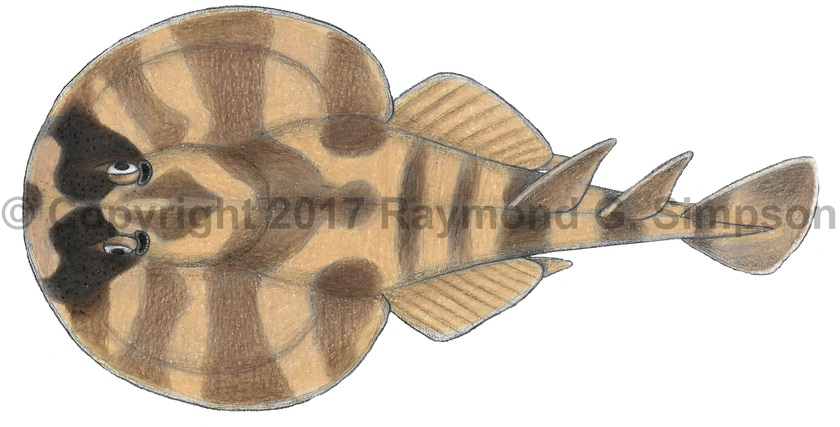
Common Name
Brazilian Electric Ray
Year Described
Olfers, 1831
Identification
Disk large, fairly thickened, and oval-shaped with kidney-shaped electric organs under each pectoral fin base. Body quite flat along entire width. Mouth relatively small with well developed labial cartilage. Teeth small but sharp (~35 rows) and not visible when mouth is closed. Eyes large and projecting. Spiracles large with short papillae (less in small fish). Nostrils fused with broad nasal curtain. Pectoral fins short. Tail a little shorter than disk with low fleshy ridges. Dorsal fins about equal in size and rounded. Second dorsal a little taller. Inter-dorsal space much shorter than length of dorsal base. Pelvic fins broad and long, without projecting anterior lobes. Pelvic fins not joined. Claspers very short and stout. Caudal fin broad with a rounded to truncate posterior margin. Claspers longer and project beyond pelvic fin in males. Skin entirely smooth.
Color
Body dull brown to grayish-brown above with diffuse large brown blotches on the dorsum. Blotches variably fused along the back. Snout marking usually apparent as a triangular dark brown marking on head. Area between these markings body color with a single blotch at the apex of snout. Smaller specimens likely with more bold, contrasting markings like the Caribbean sister species. Ventrum pale with dusky posterior edging to disk.
Size
Maximum size to 45cm TL.
Habitat
Inhabits relatively shallow continental shelf waters under 50m.
Range
Known from northern Brazil to northern Argentina.
References
Compagno, L.J.V. 2002. Sharks. In: Carpenter, K.E. (Editor) FAO Identification Guide for Fishery Purposes. The Living Marine Resources of The Western Central Atlantic. Volume 1: Introduction, mollusks, crustaceans, hagfishes, sharks, batoid fishes, and chimaeras. ASIH Special Publication No. 5. FAO, Rome.
Last, P.R., White, W.T., Carvalho, M.R. de, Séret, B., Stehmann, M.F.W & Naylor, G.J.P (Eds.). 2016. Rays of the World. CSIRO Publishing, Melbourne.
Other Notes
All records of Narcine brasiliensis from north of Brazil refer to N. bancroftii. The southern limit of N. bancroftii is unclear as the status of Narcine sp. (Smallspotted Numbfish) from northern South America has not been determined. Appears to be fully allopatric from the Brazilian species, N. brasiliensis.